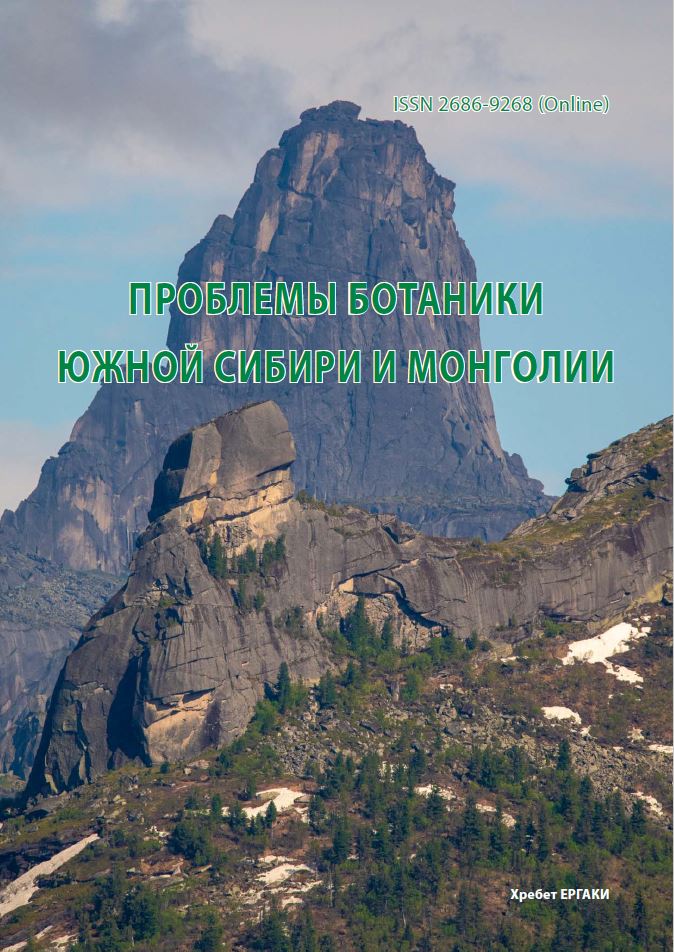Features of biology and coenopopulation characteristics of Silene cretacea Fisch. ex Spreng. on the Ilovli river valley, Volgograd region
УДК 582.669.2+574.34(470.45)
Abstract
One of the modern environmental problems is the reduction in the number of rare plant species due to an increase in anthropogenic pressure on natural phytocenoses. Cenopopulation studies of Silene cretacea Fisch. ex Spreng. will make it possible to study the real state of natural coenopopulations, which is the result of the intrapopulation distribution of individuals. We studied 7 cenopopulations of Silene cretacea in the natural conditions of the Volgograd region on the Cretaceous outcrops of the valley of the river Ilovlya, which differ in species composition and degree of anthropogenic impact. An ontogenetic strategy has been defined that corresponds to the S (patient) type, which allows the species, in the struggle for existence, due to its endurance, to exist in extremely unfavorable conditions, that is, in conditions where other species cannot survive, and therefore cannot compete with them. With the similarity of the age composition of cenopopulations in different ecological and cenotic areas, they differed from each other in terms of vitality composition. The vitality type of the studied cenopopulations changed from prosperous to depressive. The analysis of the age spectrum showed that all the studied populations are normal, incomplete, with a maximum in the generative fraction with a large proportion of plants of the generative period, with a small proportion of pregerative and senile individuals. For most individuals of the S. cretacea, normal development is common that described by the successive passage of individuals of all age states in their life cycle. Under optimal conditions, individuals of S. cretacea are characterized by slow development with slow rates of development in the middle generative age state. This is due to the specifics of the ecology of the habitat of S. cretacea (narrow ecological confinement, features of the soil substrate, etc.) and the biology of the species (seed renewal, prolonged stay of individuals in the generative state).
Downloads
Metrics
References
Абрамова Т. И. Растительность меловых обнажений степной части бассейна р. Дона в пределах Ростовской и Волгоградской областей // Бот. журн., 1973. - Т. 58, № 4. - С. 562-570.
Березуцкий М. А. Смолевка меловая - вид, пропущенный во флористических сводках для территории Саратовской области // Электронный научный журнал «Дневник науки», 2020. - № 9. URL: http://dnevniknauki.ru/ images/publications/2020/9/biology/Berezutsky.pdf.
Володина Н. Г. К флоре меловых обнажений Волгоградской области // Бюл. МОИП, Отделение биологии, 1978. - Вып. 4. - С. 142-148.
Девятов А. Г. Смолевка меловая (Silene cretacea Fisch. ex Spreng.) // Красная книга Российской Федерации. -Москва: Товарищество научных изданий КМК, 2008. - С. 172-173.
Жукова Л. А., Дорогова Ю. А., Турмухаметова Н. В., Гаврилова М. Н., Полянская Т. А. Экологические шкалы и методы анализа экологического разнообразия растений. - Йошкар-Ола: Марийский гос. ун-т, 2010. - 368 с.
Жукова Л. А. Изменение возрастного спектра популяций луговика дернистого на окских лугах при различной продолжительности выпаса // Биологические науки, 1967. - № 7. - С. 67-72.
Литвинова Н. П., Горшкова О. С. Об ареалах трех эндемичных видов меловых обнажений Русской равнины // Проблемы экологии, геоботаники, ботанической географии и флористики. - Л.: Наука, 1977. - С. 151-155.
Сагалаев В. А. Смолевка меловая - Silene cretacea Fisch. ex Spreng. // Красная книга Волгоградской области. Т. 2. Растения и грибы. - Воронеж: ООО «Издат-Принт», 2017. - Т. 2. - С. 113.
Работнов Т. А. Опыт определения возраста у травянистых растений // Бот. журн., 1946. -Т. 31, № 5. - С. 24-28.
Уранов А. А. Возрастной спектр фитоценопопуляций как функция времени и энергетических волновых процессов // Биол. науки, 1975. - № 2. - С. 7-34.
Уранов А. А., Смирнова О. В. Классификация и основные черты развития популяций многолетних растений // Бюл. МОИП. Отд. биол., 1969. - Т. 79, вып. 1. - С. 119-135.
Флора Нижнего Поволжья. Раздельнолепестные двудольнгые цветковые растения (Salicaceae - Droseraceae) // Отв. ред. Н. М. Решетникова; Главный ботанический сад РАН. - М.: Тов-во науч. изд. КМК, 2018. - Т. 2, ч. 1. -С. 254-262.
Цвелев Н. Н. Род Смолевка - Silene L. // Флора Восточной Европы. Т. 11. - М.; СПб.: Тов-во науч. изд. КМК, 2004. - С. 233- 247.
Цыганов Д. Н. Фитоиндикация экологических режимов в подзоне хвойно-широколиственных лесов. - М.: Наука, 1983. - 197 с.



